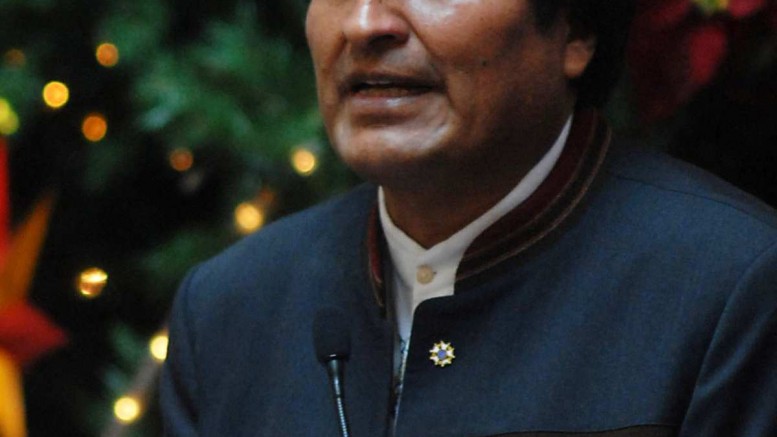The Bolivian government’s recent decision to nationalize Glencore International’s (GLEN-L)Colquiri lead-tin mine “will pose a number of serious questions relating to the government’s future policy towards foreign investment in the mining sector,” the diversified natural resources group warns.
Glencore said the nationalization was announced just as the company renegotiated mining contracts with the government that would have increased its stake in the mine to as much as 77% to 79%, and give the Bolivian government up to 55% of the mine’s profits. It would also have included further investment commitments by Glencore of more than US$160 million over the next five years, of which at least US$56 million would have been pumped into the Colquiri operation.
Charles Watenphul, a London-based spokesman for Glencore, turned down an interview request and declined to comment on other assets the company holds in the South American country, or on Bolivia’s nationalization in 2007 of the company’s Vinto tin smelter.
Colquiri had been one of Glencore’s assets held under its 100%-owned Sinchi Wayra, a company in Bolivia that operates five mining units and concentrating facilities in the Oruro and Potosi regions. Collectively the mines produce 205,000 tonnes of zinc concentrate, 15,000 tonnes of lead concentrate and 6,000 tonnes of tin concentrate a year.
Karen Hooper, an analyst at geopolitical analysis firm Stratfor, says Glencore got caught in the middle of a local dispute that began in May, in which the government felt it needed to intervene.
Specifically, more than 1,000 members of a co-operative called the 26 de Febrero, which operates a large portion of the mine’s mineral deposits, occupied Colquiri, claiming that it owned a disputed portion of the mine. The Federated Union of Bolivian Mine Workers — which represents 400 workers employed by Glencore’s Sinchi Wayra — went on strike, and asked the government to nationalize the mine. The National Federation of Bolivian Co-operative Miners stepped in and said that the government had no claim over the co-operative-controlled parts of the mine.
“There were violent clashes between the co-operative union and the police, and it snowballed. Once the government starts to get involved you can bet one of the first things they consider is nationalization to pacify the unrest,” Hooper says.
The Texas-based analyst says the foreign mining community will see more influence wielded by local co-operatives in places where wildcat mining is profitable and the main mode of extracting resources, as opposed to larger mineral deposits and mines where the country lacks the technical capacity to extract the resources itself. “We’re not talking about Bolivia coming in and operating large open-pit mines and larger facilities,” she says.
While nationalization has always been a policy of President Evo Morales’ government, it’s not always blanket nationalization, Hooper argues. As evidence she cites the “nationalization” earlier this year of U.S.-based Pan American Energy, which has a stake in a huge natural gas project in the country. “It was nationalized in name, but then the government never followed up on the nationalization and never actually took it,” Hooper says. “So the government uses the threat of nationalization as a bargaining tool with companies in the country.”
Hooper says nationalization in Bolivia stems in part from the ruling ideology that natural resources in the country should benefit the people and not be monopolized by foreign interests. But it is also the tactic of a government that has few resources at its disposal.
“Personally I wouldn’t wish being president of Bolivia on anyone,” she adds. “It’s hard to be a government with so few resources in such a large space.”
She also points to the strong geographic divide in the country that reinforces differences between Bolivia’s lowlands, which are primarily agricultural and tend to be dominated by wealthier groups, and the highlands, where there are greater concentrations of poorer Indian or native populations, and where 23 different languages are spoken.
“It’s those poorer populations that Morales came to power representing,” she says. “He was one of the first to shift power from the slightly more rich elite in the south to the more indigenous populations in the highlands.”
Mining in Bolivia makes up 15% of the country’s gross domestic product, according to a Stratfor report, “and has been idling under the Morales administration.”
“The 2009 constitution requires the government to take a majority stake in mineral deposits,” the report continues. “Bolivia and its foreign investors have been negotiating how control would be divided ever since that statute took effect . . . this shifting, regulatory climate and the general uncertainty of operating conditions have reduced foreign investment in Bolivia’s mining sector.”
But there are a number of mining companies with assets in the country, including Liongold of Singapore, New World Resource (NW-T), Pan American Silver (PAA-T, PAAS-Q), Coeur d’Alene Mines (CDM-T, CDE-N), South American Silver (SAC-T, SOHAF-O) and China National Gold Group.


Be the first to comment on "Bolivian gov’t seizes Glencore’s Colquiri mine"